*NURSING > TEST BANKS > (Complete 2022) Test Bank For Seidel's Guide to Physical Examination An Interprofessional Approach 1 (All)
(Complete 2022) Test Bank For Seidel's Guide to Physical Examination An Interprofessional Approach 10th Edition by Jane W. Ball, Joyce E. Dains Chapter 1-26; Ace in your Exams in 1 attempt!
Document Content and Description Below
(Complete 2022) Test Bank For Seidel's Guide to Physical Examination An Interprofessional Approach 10th Edition by Jane W. Ball, Joyce E. Dains Chapter 1-26; Ace in your Exams in 1 attempt! Seidel's ... Guide to Physical Examination: An Interprofessional Approach (Mosby's Guide to Physical Examination) 10th Edition Test Bank For Seidel's Guide to Physical Examination An Interprofessional Approach 10th Edition by Jane W. Ball, Joyce E. Dains Chapter 1-26 Chapter 01: Cultural Competency Ball: Seidel’s Guide to Physical Examination, 10th Edition MULTIPLE CHOICE 1. Which statement is true regarding the relationship of physical characteristics and culture? a. Physical characteristics should be used to identify members of cultural groups. b. There is a difference between distinguishing cultural characteristics and distinguishing physical characteristics. c. To be a member of a specific culture, an individual must have certain identifiable physical characteristics. d. Gender and race are the two essential physical characteristics used to identify cultural groups. ANS: B Physical characteristics are not used to identify cultural groups; there is a difference between the two, and they are considered separately. Physical characteristics should not be used to identify members of cultural groups. To be a member of a specific culture, an individual does not need to have certain identifiable physical characteristics. You should not confuse physical characteristics with cultural characteristics. Gender and race are physical characteristics, not cultural characteristics, and are not used to identify cultural groups. DIF:Cognitive Level: Understanding (Comprehension) OBJ:Nursing process—assessment MSC: Physiologic Integrity: Physiologic Adaptation 2. An image of any group that rejects its potential for originality or individuality is known as a(n) a. acculturation. b. norm. c. stereotype. d. ethnos. ANS: C A fixed image of any group that rejects its potential for originality or individuality is the definition of stereotype. Acculturation is the process of adopting another culture’s behaviors. A norm is a standard of allowable behavior within a group. Ethnos implies the same race or nationality. DIF:Cognitive Level: Remembering (Knowledge) OBJ:Nursing process—assessment MSC: Physiologic Integrity: Physiologic Adaptation 3. Mr. L presents to the clinic with severe groin pain and a history of kidney stones. Mr. L’s son tells you that for religious reasons, his father wishes to keep any stone that is passed into the urine filter that he has been using. What is your most appropriate response? a. ―With your father’s permission, we will examine the stone and request that it be returned to him.‖ b. ―The stone must be sent to the lab for examination and therefore cannot be kept.‖ c. ―We cannot let him keep his stone because it violates our infection control policy.‖ d. ―We don’t know yet if your father has another kidney stone, so we must analyze this one.‖ ANS: A We should be willing to modify the delivery of health care in a manner that is respectful and in keeping with the patient’s cultural background. ―With your father’s permission, we will examine the stone and request that it be returned to him‖ is the most appropriate response. ―The stone must be sent to the lab for examination and therefore cannot be kept‖ and ―We don’t know yet if your father has another kidney stone, so we must analyze this one‖ do not support the patient’s request. ―We cannot let him keep his stone because it violates our infection control policy‖ does not provide a reason that it would violate an infection control policy. DIF:Cognitive Level: Analyzing (Analysis) OBJ:Nursing process—assessment MSC: Physiologic Integrity: Physiologic Adaptation 4. The motivation of the healthcare professional to ―want to‖ engage in the process of becoming culturally competent, not ―have to,‖ is called a. cultural knowledge. b. cultural awareness. c. cultural desire. d. cultural skill. ANS: C Cultural encounters are the continuous process of interacting with patients from culturally diverse backgrounds to validate, refine, or modify existing values, beliefs, and practices about a cultural group and to develop cultural desire, cultural awareness, cultural skill, and cultural knowledge. Cultural awareness is deliberate self-examination and in-depth exploration of one’s biases, stereotypes, prejudices, assumptions, and ―-isms‖ that one holds about individuals and groups who are different from them. Cultural knowledge is the process of seeking and obtaining a sound educational base about culturally and ethnically diverse groups. Cultural skill is the ability to collect culturally relevant data regarding the patient’s presenting problem, as well as accurately performing a culturally based physical assessment in a culturally sensitive manner. Cultural desire is the motivation of the healthcare professional to want to engage in the process of becoming culturally competent, not have to. DIF:Cognitive Level: Understanding (Comprehension) OBJ:Nursing process—assessment MSC: Physiologic Integrity: Physiologic Adaptation 5. Mr. Marks is a 66-year-old patient who presents for a physical examination to the clinic. Which question has the most potential for exploring a patient’s cultural beliefs related to a health problem? a. ―How often do you have medical examinations?‖ b. ―What is your age, race, and educational level?‖ c. ―What types of symptoms have you been having?‖ d. ―Why do you think you are having these symptoms?‖ ANS: D ―Why do you think you are having these symptoms?‖ is an open-ended question that avoids stereotyping, is sensitive and respectful toward the individual, and allows for cultural data to be exchanged. The other questions do not explore the patient’s cultural beliefs about health problems. DIF:Cognitive Level: Analyzing (Analysis) OBJ:Nursing process—assessment MSC: Physiologic Integrity: Physiologic Adaptation 6. The definition of ill or sick is based on a a. stereotype. b. cultural behavior. c. belief system. d. cultural attitude. ANS: C The definition of ill or sick is based on the individual’s belief system and is determined in large part by his or her enculturation. DIF:Cognitive Level: Understanding (Comprehension) OBJ:Nursing process—assessment MSC: Physiologic Integrity: Physiologic Adaptation 7. A 22-year-old female nurse is interviewing an 86-year-old male patient. The patient avoids eye contact and answers questions only by saying, ―Yeah,‖ ―No,‖ or ―I guess so.‖ Which of the following is appropriate for the interviewer to say or ask? a. ―We will be able to communicate better if you look at me.‖ b. ―It’s hard for me to gather useful information because your answers are so short.‖ c. ―Are you uncomfortable talking with me?‖ d. ―Does your religion make it hard for you to answer my questions?‖ ANS: C It is all right to ask if the patient is uncomfortable with any aspect of your person and to talk about it; the other choices are less respectful. DIF:Cognitive Level: Applying (Application) OBJ:Nursing process—assessment MSC: Physiologic Integrity: Physiologic Adaptation 8. As you explain your patient’s condition to her husband, you notice that he is leaning toward you and pointedly blinking his eyes. Knowing that he is from England, your most appropriate response to this behavior is to a. tell him that you understand his need to be alone. b. ask whether he has any questions. c. ask whether he would prefer to speak to the clinician. d. tell him that it is all right to be angry. ANS: B The English worry about being overheard and tend to speak in modulated voices so, when they lean in toward you, they are probably poised to ask a question. DIF:Cognitive Level: Analyzing (Analysis) OBJ:Nursing process—assessment MSC: Physiologic Integrity: Physiologic Adaptation 9. An aspect of traditional Western medicine that may be troublesome to many Hispanics, Native Americans, Asians, and Middle Eastern groups is Western medicine’s attempts to a. use a holistic approach that views a particular medical problem as part of a bigger picture. b. determine a specific cause for every problem in a precise way. c. establish harmony between a person and the entire cosmos. d. restore balance in an individual’s life. ANS: B A more scientific approach to healthcare problem solving, in which a cause can be determined for every problem in a precise way, is a Western approach. Hispanics, Native Americans, Asians, and Arabs embrace a more holistic approach. Using a holistic approach, establishing harmony between a person and the entire cosmos, and restoring balance in an individual’s life would not be troublesome to many Hispanics, Native Americans, Asians, and Arabs. DIF:Cognitive Level: Understanding (Comprehension) OBJ:Nursing process—assessment MSC: Physiologic Integrity: Physiologic Adaptation 10. The attitudes of the healthcare professional a. are largely irrelevant to the success of relationships with the patient. b. do not influence patient behavior. c. are difficult for the patient to sense. d. are culturally derived. ANS: D The attitudes of the healthcare provider are foundationally derived from his or her own culture; understanding this is relevant to the success of patient relationships. Attitudes of the healthcare professional are easily detected by others, and they influence patient behavior; they are not irrelevant to the success of relationships with the patient; they do influence patient behavior; and they are not difficult for the patient to sense. DIF:Cognitive Level: Understanding (Comprehension) OBJ:Nursing process—assessment MSC: Physiologic Integrity: Physiologic Adaptation 11. Mr. Sanchez is a 45-year-old gentleman who has presented to the office for a physical examination to establish a new primary care healthcare provider. Which of the following describes a physical, not a cultural, differentiator? a. Race b. Rite c. Ritual d. Norm ANS: A Race is a physical, not a cultural, differentiator. Rite is a prescribed, formal, customary observance. Ritual is a stereotypic behavior regulating religious, social, and professional behaviors. A norm is a prescribed standard of allowable behavior within a group. DIF:Cognitive Level: Remembering (Knowledge) OBJ:Nursing process—assessment MSC: Physiologic Integrity: Physiologic Adaptation 12. Mr. Abdul is a 40-year-old Middle Eastern man who presents to the office for a first visit with the complaint of new abdominal pain. You are concerned about violating a cultural prohibition when you prepare to do his rectal examination. The best tactic would be to a. forego the examination for fear of violating cultural norms. b. ask a colleague from the same geographic area if this examination is acceptable. c. inform the patient of the reason for the examination and ask if it is acceptable to him. d. refer the patient to a provider more knowledgeable about cultural differences. **************************CONTINUED all chapters [Show More]
Last updated: 2 years ago
Preview 1 out of 215 pages
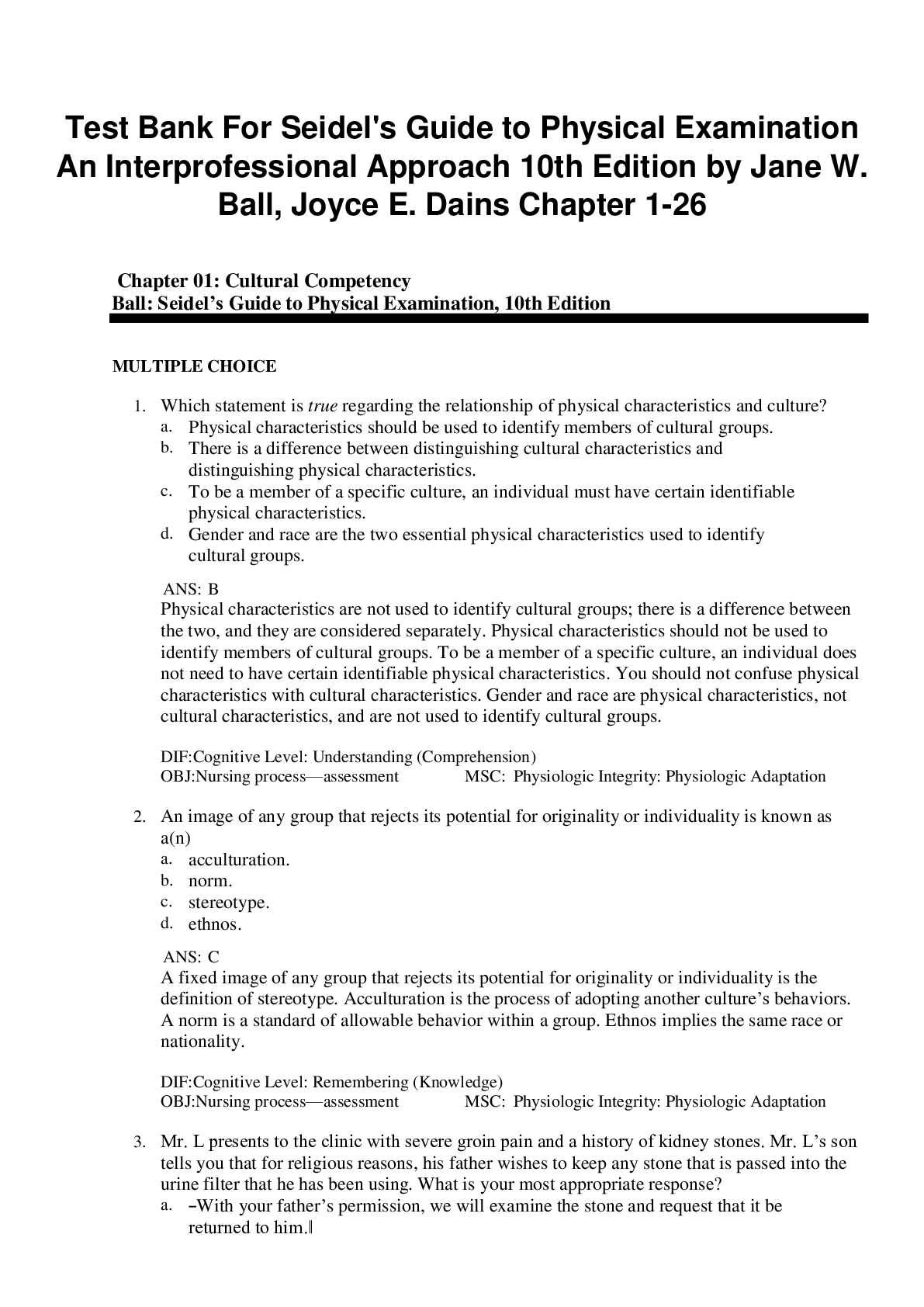
Buy this document to get the full access instantly
Instant Download Access after purchase
Buy NowInstant download
We Accept:

Reviews( 0 )
$10.00
Can't find what you want? Try our AI powered Search
Document information
Connected school, study & course
About the document
Uploaded On
Aug 21, 2022
Number of pages
215
Written in
Additional information
This document has been written for:
Uploaded
Aug 21, 2022
Downloads
2
Views
319

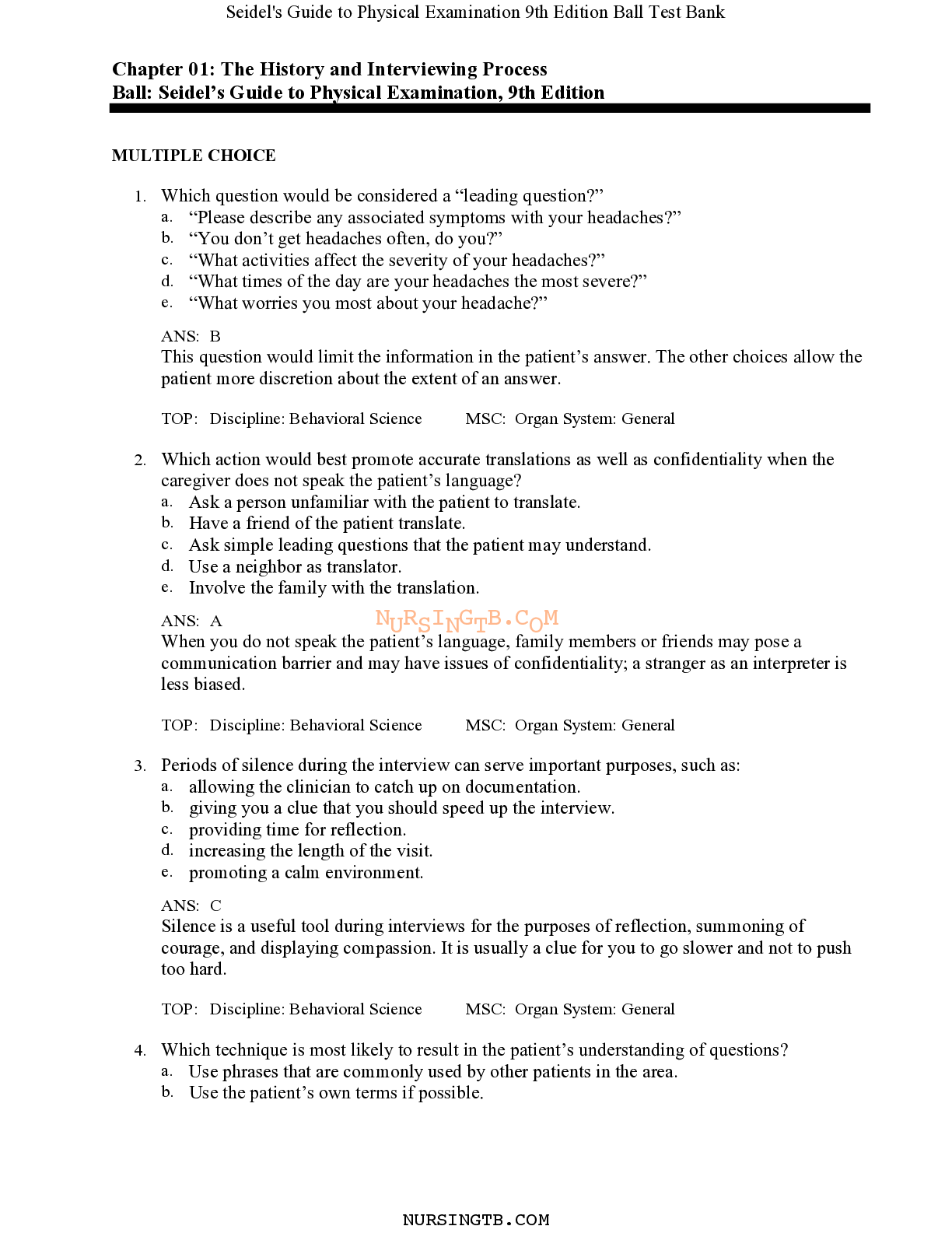


_compressed.png)


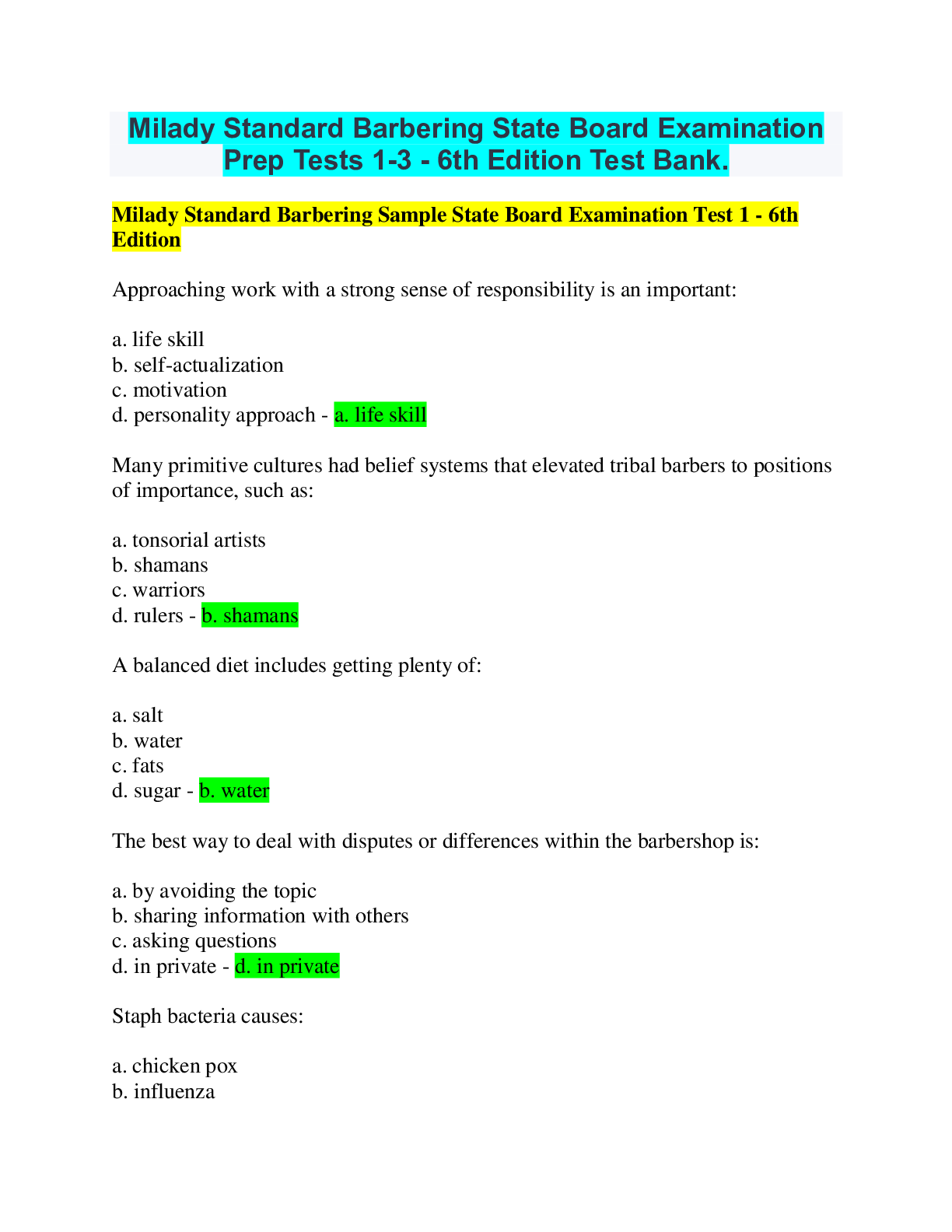

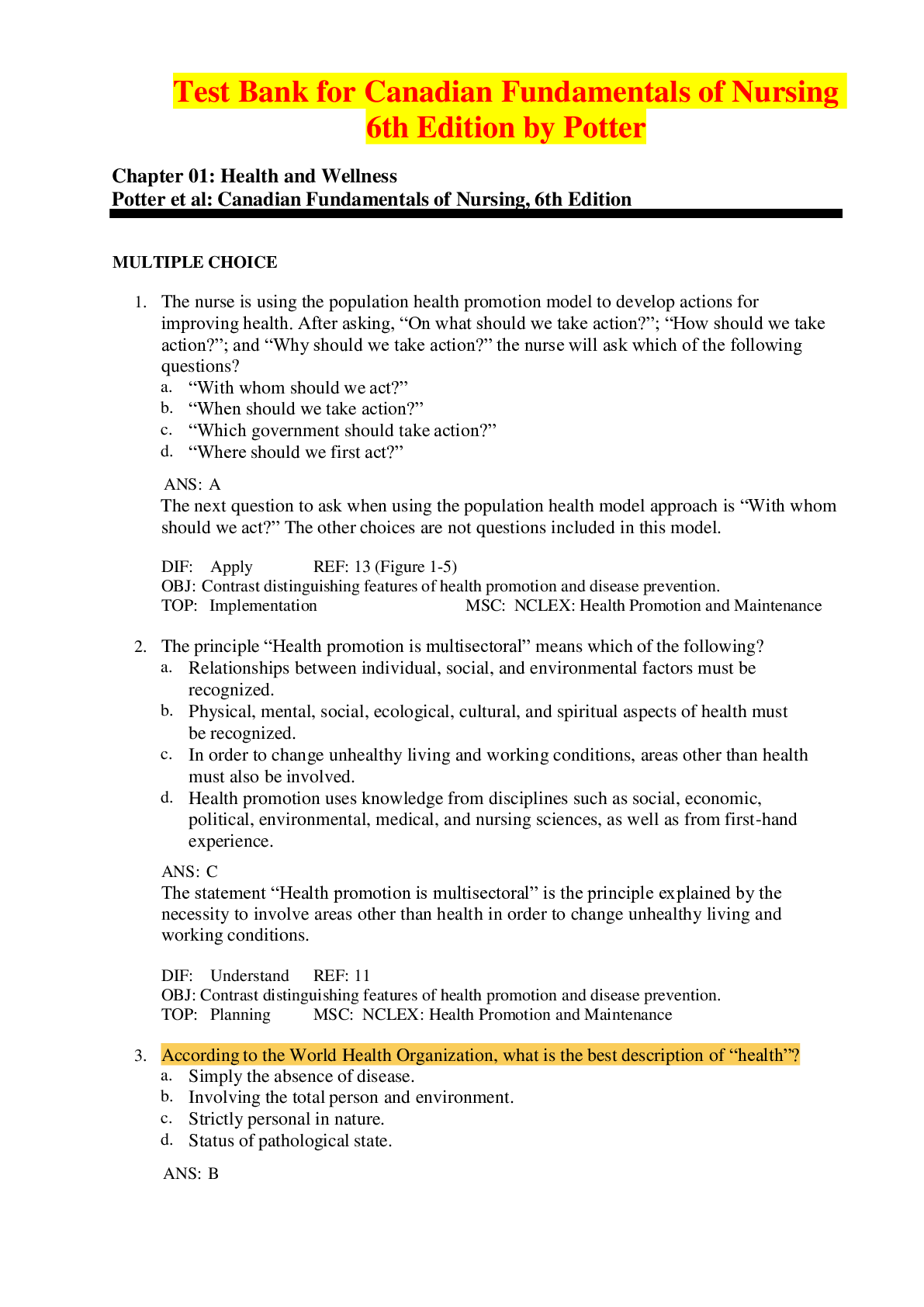
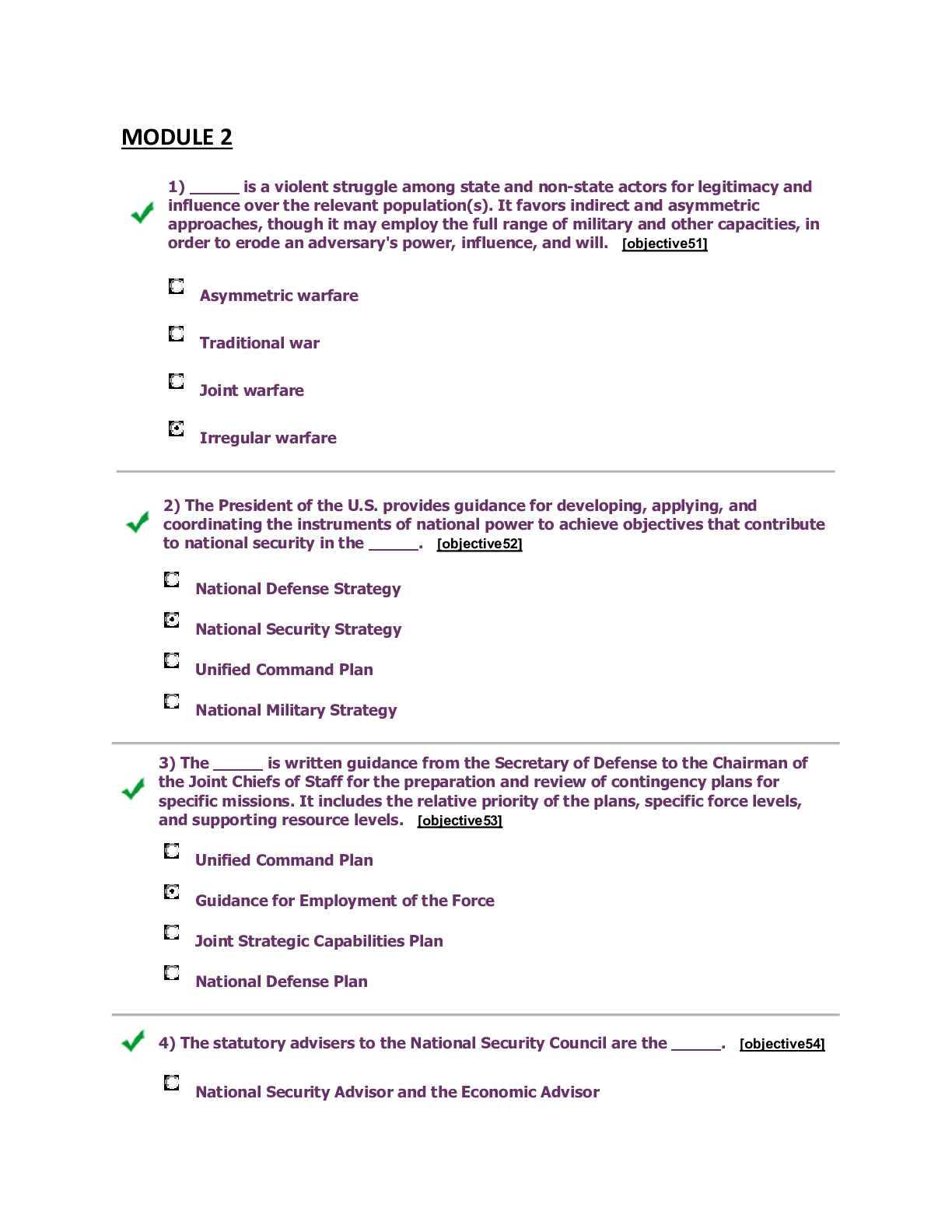

.png)













